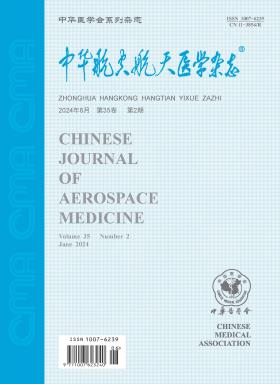Effects of high + Gz exposure on saliva α-amylase of fighter pilots
引用次数: 0
Abstract
Objective To investigate the influence of +Gz acceleration on saliva a-amylase (SAA) of pilots,so as to assess the feasibility of taking SAA as an indicator of +Gz stress on pilots.Methods Saliva was collected from 47 pilots before and after + 6.5 Gz,+ 7.0 Gz and + 8.0 Gz centrifuge exposures.The SAA was measured by a-amylase kit (dynamic monitoring method) and chemiluminescnet immunoassay.Results ①The SAA and cortisol levels significantly changed by different +Gz exposures (F= 17.712,3.427,P<0.01 or P<0.05).Compared with that before exposures,the SAA levels measured after +6.5 Gz,+ 7.0 Gz and +8.0 Gz exposures were significantly higher (P<0.01).The cortisol levels after +7.0 Gz and +8.0 Gz exposures were significantly higher than the baseline (P<0.05 or 0.01).The cortisol level obtained after +8.0 Gz exposure was significantly higher than that before + 6.5 Gz,+ 7.0 Gz and + 8.0 Gz centrifuge exposures (P<0.05).②Multivariate analysis showed that the aircraft type,pilot's age and flying hours had no influence on SAA and cortisol levels obtained after +Gz exposures.③ Pilots' cortisol levels were negatively correlated to the age and aircraft type of (r=-0.328,-0.694,P<0.05) but positively correlated to flying hours and +Gz level (r=0.466,0.141,P<0.05).SAA was positively correlated to +Gz level (r=0.354,P<0.01).④The levels of cortisol and SAA had less correlation either before or after +Gz exposure.Conclusions SAA elevates sensitivity with +Gz stress increase and quickly returns to baseline.So we can conclude that SAA could be a valid indicator of +Gz stress. Key words: Acceleration; Stress; Saliva; Alpha-amylase高+ Gz暴露对战斗机飞行员唾液α-淀粉酶的影响
目的探讨+Gz加速对飞行员唾液a-淀粉酶(SAA)的影响,评价将SAA作为飞行员+Gz应激指标的可行性。方法采集47名飞行员+ 6.5 Gz、+ 7.0 Gz和+ 8.0 Gz离心暴露前后的唾液。采用a-淀粉酶试剂盒(动态监测法)和化学发光免疫分析法测定SAA。结果①不同+Gz暴露对SAA和皮质醇水平有显著影响(F= 17.712,3.427,P<0.01或P<0.05)。与暴露前相比,+ 6.5 Gz、+ 7.0 Gz和+8.0 Gz暴露后SAA水平显著升高(P<0.01)。+7.0 Gz和+8.0 Gz暴露后皮质醇水平显著高于基线(P<0.05或0.01)。+8.0 Gz暴露后皮质醇水平显著高于+ 6.5 Gz、+ 7.0 Gz和+8.0 Gz暴露前(P<0.05)。②多因素分析表明,飞机类型、飞行员年龄和飞行时间对+Gz暴露后的SAA和皮质醇水平没有影响。③飞行员皮质醇水平与年龄、机型负相关(r=-0.328,-0.694,P<0.05),与飞行时数、+Gz水平正相关(r=0.466,0.141,P<0.05)。SAA与+Gz水平呈正相关(r=0.354,P<0.01)。④皮质醇水平与SAA水平在+Gz暴露前后相关性较低。结论SAA敏感性随+Gz应激增加而升高,并迅速恢复到基线水平。因此,我们可以得出结论,SAA可以作为+Gz应力的有效指标。关键词:加速度;压力;唾液;阿尔法
本文章由计算机程序翻译,如有差异,请以英文原文为准。
求助全文
约1分钟内获得全文
求助全文
来源期刊

中华航空航天医学杂志
航空航天医学
自引率
0.00%
发文量
2962
期刊介绍:
The aim of Chinese Journal of Aerospace Medicine is to combine theory and practice, improve and popularize, actively advocate a hundred flowers bloom and a hundred schools of thought contend, advocate seeking truth from facts, promote the development of the related disciplines of aerospace medicine and human efficiency, and promote the exchange and penetration of aerospace medicine and human efficiency with other biomedical and engineering specialties.
Topics of interest for Chinese Journal of Aerospace Medicine include:
-The content of the journal belongs to the discipline of special medicine and military medicine, with the characteristics of multidisciplinary synthesis and cross-penetration, and mainly reflected in the aerospace industry, aerospace flight safety and efficiency, as well as the synthesis of special medicine, preventive medicine, environmental medicine, psychology, etc.
-Military aeromedicine (Air Force, Navy and Army aeromedicine) and civil aeromedicine, with a balance of aerospace medicine are the strengths of the journal.
-The change in aerospace medicine from a focus on promoting physiological compensatory adaptations to enhancing human performance under extreme environmental conditions is what the journal is helping to promote.
-The expansion of manuscripts in high altitude medicine is also a special emphasis of the journal.
 求助内容:
求助内容: 应助结果提醒方式:
应助结果提醒方式:


